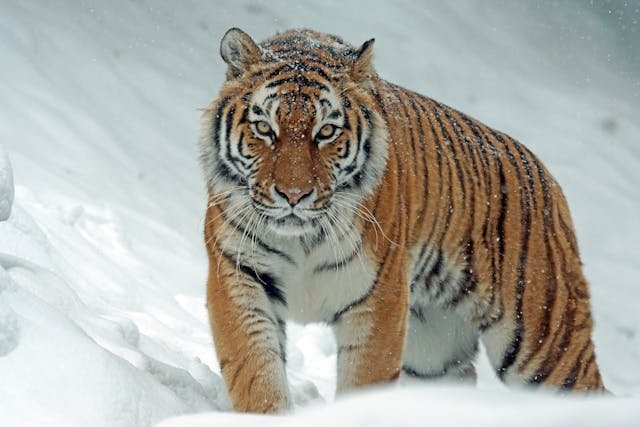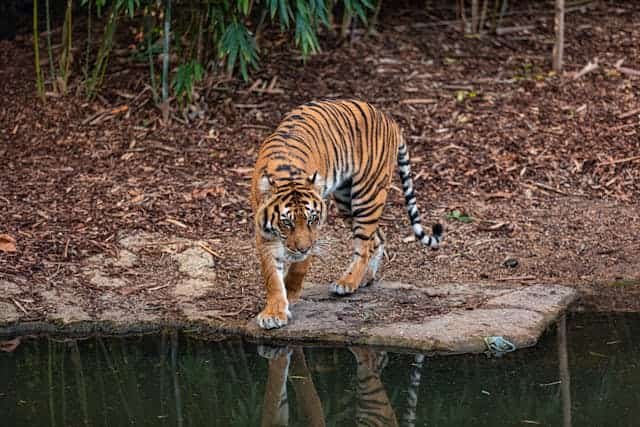Physical Address
304 North Cardinal St.
Dorchester Center, MA 02124
Physical Address
304 North Cardinal St.
Dorchester Center, MA 02124

Tigers are the largest big cats roaming the Earth. The Siberian tiger and the Bengal tiger two types of tigers naturally roam the supercontinent of Eurasia. But how can one differentiate between Siberian tigers vs Bengal tigers?
Unless you are a tiger biologist, it is difficult to differentiate between a Siberian tiger and a Bengal tiger. Tigers naturally almost have the same traits but you have noticed, these two types of tigers we are talking about prefer to live in different climates.
The Siberian tiger is the largest big cat on Earth and they prefer to live in the woodlands in the far east of the northern hemisphere. The Bengal tiger prefers to inhabit the forecast and mangrove swamps of India, Bangladesh, Burma, Nepal, and Bhutan.
The Siberian tiger and Bengal tiger may share a common ancestry and belong to the same Panthera tigris species, but some differences highlight their uniqueness.

The Siberian tiger, also known as the Amur tiger is the largest and heaviest big cat in the world. The Amur tiger is a population of the tiger subspecies called Panthera tigris tigris native to the far east of the supercontinent of Eurasia.
These tigers are found in Far East Russia, Northeast China, and sometimes in North Korea. Amur tigers once roamed throughout the Korean Peninsula. But today, they are mainly found in the Sikhote-Alin mountain region in Far East Russia.
The Siberian tiger is an endangered species and over the last few decades, efforts have been made to increase their population. The population of tigers back in 2005 were 331 to 393 adults and subadults in the Sikhote-Alin mountain region of Russia.
The population of breeding adult Siberian tigers were up to 250. The population of the big cats was stable for over a decade. However, a partial survey conducted after a few years indicated a population decline.
The population of the Siberian tiger increased after a survey in 2015. The tiger population was up to 480 or more tigers roaming the woodlands of Far East Russia. The survey also indicated that about 100 cubs were born.
Another detailed census revealed that the population of tigers in Far East Russia was 562. Today, less than 600 Siberian tigers are left in the wild, with a few hundred kept in zoos across the world.
The Siberian tigers can be called different names based on the region where they are found. A few names include the Manchurian tiger, the Ussurian tiger, and the Korean tiger.
Also Read: Canine vs Feline: Difference and Comparison

The Bengal tiger is native to the Indian subcontinent, mainly inhabiting the forecast and mangrove swamps of India, Nepal, Bhutan, Bangladesh, and Burma. Bengal tigers are a population of the Panthera tigris tigris subspecies, presently ranked among the largest wild cats in the world.
The Bengal tiger is believed to have been present in the subcontinent of India for about 12,000 to 16,500 years. Like the Siberian tiger, the population of the Bengal tiger is on a decline. This is because of the loss of natural habitat and poaching.
Based on a survey conducted in 2011, fewer than 2,500 Bengal tigers are left in the wild.
The Bengal tiger naturally inhabits the Indian subcontinent, and parts of southwestern China.
The population of Bengal tigers in India was estimated at over 2,600 to 3,300 in 2018. About 90 tigers were estimated to be in Bhutan and about 300 to 500 individuals in Bangladesh by 2015.
Additionally, Nepal had about 255 individuals by 2022.
There are physical traits that differentiate the Siberian tiger from the Bengal tiger. They are both big wild cats but the Siberian tiger is the largest and prefers a colder climate, unlike the Bengal tiger which naturally inhabits the mangrove swamps of the Indian subcontinent.
Also Read: Buck vs Stag: Difference and Comparison
The Siberian tiger and the Bengal tiger prefer to inhabit different regions with different climates and terrains. Although these tigers may look similar, their preferences in terms of natural habitat are completely different.
The Siberian tiger prefers the cold weather and snowy forests in the far east of the northern hemisphere. They are mainly found in Far East Russia, Northeast China, and North Korea.
The Bengal tiger thrives in the mangrove swamps of the Indian subcontinent. These large wild cats prefer humid and damp habitats like deciduous forests.
The natural habitat of these wild cats also affects their appearance and diet. The Siberian tiger is a large carnivore that prey on smaller deer species and large moose species.
The Bengal tiger also prey on smaller deer species found on the Indian subcontinent.
Another major difference between the Siberian tiger and the Bengal tiger is their appearance. As we said earlier, unless you are a tiger biologist, it will be difficult to differentiate a Siberian tiger from a Bengal tiger.
Siberian tigers appear to have a lighter-coloured coat- a unique physical trait caused by the snowy weather these wild cats live in for the majority of the year. Siberian tigers also have a light reddish-orange coat with brown stripes.
Unlike Siberian tigers, Bengal tigers have a darker yellowish coat and black stripes.
The Siberian tiger and the Bengal tiger have different fur and patterns that enable them to blend into their natural habitats. This provides the big cats with the perfect camouflage to stalk and hunt prey in the wild.
Also Read: Cockroach vs Beetle: Difference and Comparison
The Siberian tiger is the world’s largest and heaviest wild cat. The Bengal tiger is also large, but compared to the Siberian tiger, it’s only an average-sized wild cat.
The male is always larger and heavier than the female, outweighing the female by a few pounds.
Male Siberian tigers can grow up to 7 to 12 feet (213 to 365 cm) in length, whereas male Bengal tigers grow up to 6 to 10 feet (182 to 304 cm) in length. Siberian tigers also outweigh Bengal tigers.
On average, both the Siberian tiger and Bengal tiger can weigh up to 600 pounds (272 kilograms), but the former weighs slightly more.
Also Read: Slug vs Snail: Difference and Comparison
Siberian tigers naturally prefer to inhabit colder climates. These big wild cats roam the woodlands in Eastern Russia, Northeast China and North Korea.
Bengal tigers are mainly found in the Indian subcontinent in the mangrove swamps of India, Burma, Nepal, Bhutan, and Bangladesh. They prefer warmer climates where they hunt for smaller deer species.
| Siberian Tigers | Bengal Tigers | |
| Appearance | Brown stripes, with a thick fur coat. A lighter orange or yellowish coat, with a rust colour. | Bengal tigers have a darker yellowish coat and black stripes. |
| Genus | Panthera | Panthera |
| Habitat | Snowy thunder and coniferous forests; woodlands in colder climates | Prefer humid areas; mangrove swamps, deciduous forests and grasslands. |
| Size | 7 to 12 feet (213 to 365 cm) in length and weighs about 300 to 600 pounds (136 to 272 kilograms) | 6 to 10 feet (182 to 304 cm) in length and weights up to 200 to 600 pounds (90 to 272 kilograms) |
| Location | Eastern Russia, Northeast China, and North Korea. | The Indian subcontinent and southwestern China. |
Tigers are wild cats found in Eurasia, the largest continental area on Earth. The Siberian tiger and the Bengal tiger are among the world’s largest carnivores.
These big cats may appear identical, but they have distinct features that make them unique. The largest and heaviest wild cat is the male Siberian tiger, while the Bengal tiger can also grow to a great length.